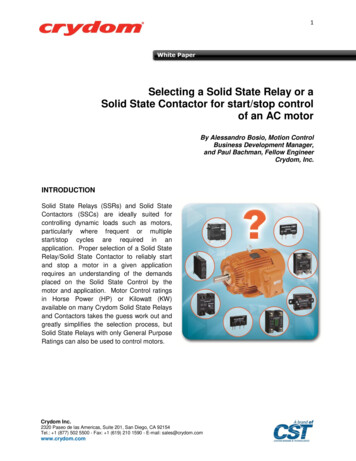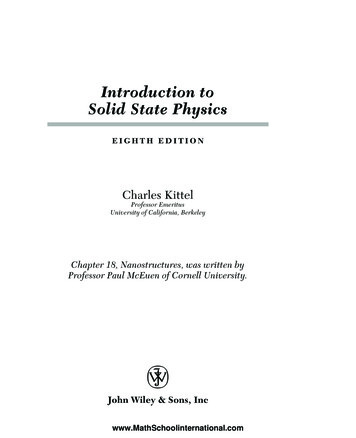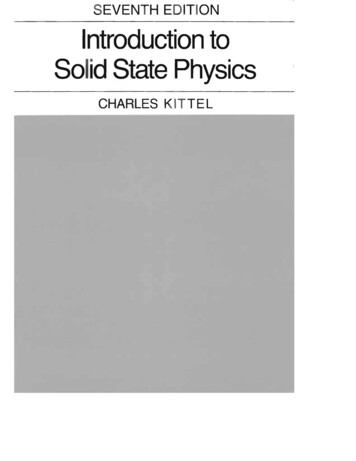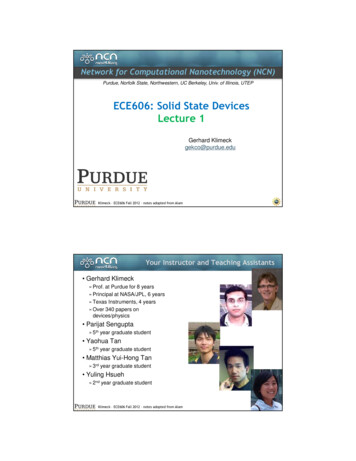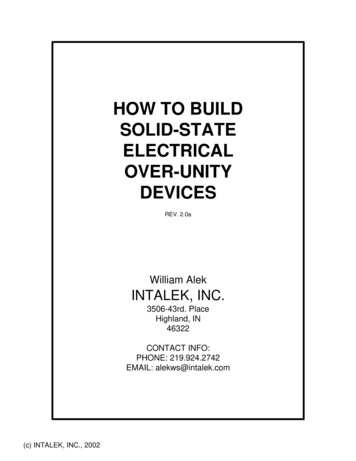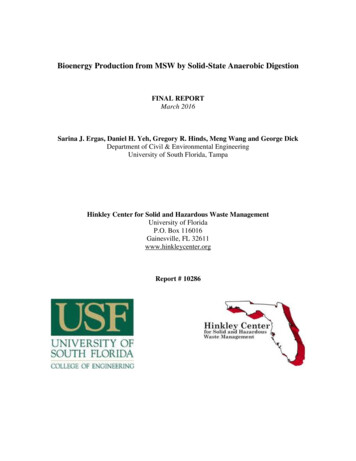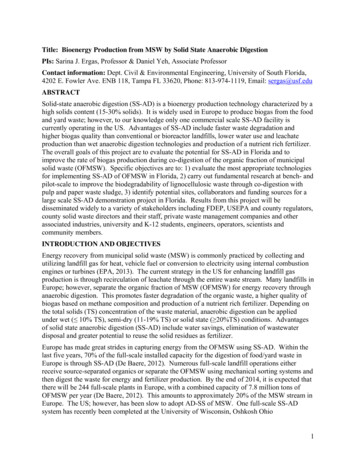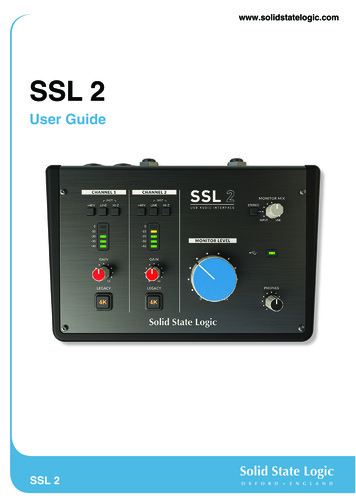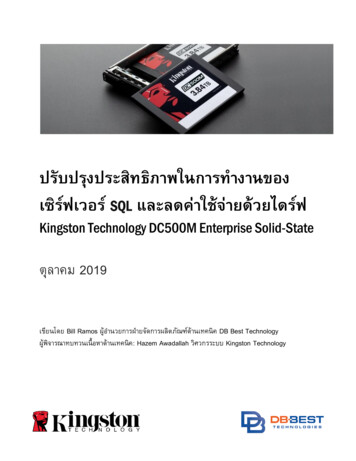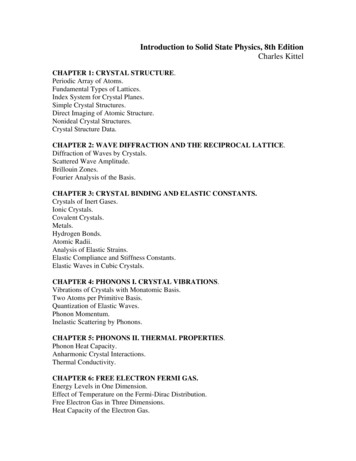
Transcription
Introduction to Solid State Physics, 8th EditionCharles KittelCHAPTER 1: CRYSTAL STRUCTURE.Periodic Array of Atoms.Fundamental Types of Lattices.Index System for Crystal Planes.Simple Crystal Structures.Direct Imaging of Atomic Structure.Nonideal Crystal Structures.Crystal Structure Data.CHAPTER 2: WAVE DIFFRACTION AND THE RECIPROCAL LATTICE.Diffraction of Waves by Crystals.Scattered Wave Amplitude.Brillouin Zones.Fourier Analysis of the Basis.CHAPTER 3: CRYSTAL BINDING AND ELASTIC CONSTANTS.Crystals of Inert Gases.Ionic Crystals.Covalent Crystals.Metals.Hydrogen Bonds.Atomic Radii.Analysis of Elastic Strains.Elastic Compliance and Stiffness Constants.Elastic Waves in Cubic Crystals.CHAPTER 4: PHONONS I. CRYSTAL VIBRATIONS.Vibrations of Crystals with Monatomic Basis.Two Atoms per Primitive Basis.Quantization of Elastic Waves.Phonon Momentum.Inelastic Scattering by Phonons.CHAPTER 5: PHONONS II. THERMAL PROPERTIES.Phonon Heat Capacity.Anharmonic Crystal Interactions.Thermal Conductivity.CHAPTER 6: FREE ELECTRON FERMI GAS.Energy Levels in One Dimension.Effect of Temperature on the Fermi-Dirac Distribution.Free Electron Gas in Three Dimensions.Heat Capacity of the Electron Gas.
Electrical Conductivity and Ohm’s Law.Motion in Magnetic Fields.Thermal Conductivity of Metals.CHAPTER 7: ENERGY BANDS.Nearly Free Electron Model.Bloch Functions.Kronig-Penney Model.Wave Equation of Electron in a Periodic Potential.Number of Orbitals in a Band.CHAPTER 8: SEMICONDUCTOR CRYSTALS.Band Gap.Equations of Motion.Intrinsic Carrier Concentration.Impurity Conductivity.Thermoelectric Effects.Semimetals.Superlattices.CHAPTER 9: FERMI SURFACES AND METALS.Construction of Fermi Surfaces.Electron Orbits, Hole Orbits, and Open Orbits.Calculation of Energy Bands.Experimental Methods in Fermi Surface Studies.CHAPTER 10: SUPERCONDUCTIVITY.Experimental Survey.Theoretical Survey.High-Temperature Superconductors.CHAPTER 11: DIAMAGNETISM AND PARAMAGNETISM.Langevin Diamagnetism Equation.Quantum Theory of Diamagnetism of Mononuclear Systems.Paramagnetism.Quantum Theory of Paramagnetism.Cooling by Isentropic Demagnetization.Paramagnetic Susceptibility of Conduction Electrons.CHAPTER 12: FERROMAGNETISM AND ANTIFERROMAGNETISM.Ferromagnetic Order.Magnons.Neutron Magnetic Scattering.Ferrimagnetic Order.Antiferromagnetic Order.Ferromagnetic Domains.
Single Domain Particles.CHAPTER 13: MAGNETIC RESONANCE.Nuclear Magnetic Resonance.Line Width.Hyperfine Splitting.Nuclear Quadrupole Resonance.Ferromagnetic Resonance.Antiferromagnetic Resonance.Electron Paramagnetic Resonance.Principle of Maser Action.CHAPTER 14: PLASMONS, POLARITONS, AND POLARONS.Dielectric Function of the Electron Gas.Plasmons.Electrostatic Screening.Polaritons.Electron-Electron Interaction.Electron-Phonon Interaction: Polarons.Peierls Instability of Linear Metals.CHAPTER 15: OPTICAL PROCESSES AND EXCITONS.Optical Reflectance.Excitons.Raman Effects in Crystals.Energy Loss of Fast Particles in a Solid.CHAPTER 16: DIELECTRICS AND FERROELECTRICS.Macroscopic Electric Field.Local Electric Field at an Atom.Dielectric Constant and Polarizability.Structural Phase Transitions.Ferroelectric Crystals.Displacive Transitions.CHAPTER 17: SURFACE AND INTERFACE PHYSICS.Surface Crystallography.Surface Electronic Structure.Magnetoresistance in a Two-Dimensional Channel.p-n Junctions.Heterostructures.Semiconductor Lasers.Light-Emitting Diodes.
CHAPTER 18: NANOSTRUCTURES.Imaging Techniques for Nanostructures.Electronic Structure of 1D Systems.Electrical Transport in 1D.Electronic Structure of 0D Systems.Electrical Transport in 0D.Vibrational and Thermal Properties of Nanostructures.CHAPTER 19: NONCRYSTALLINE SOLIDS.Diffraction Pattern.Glasses.Amorphous Ferromagnets.Amorphous Semiconductors.Low Energy Excitations in Amorphous Solids.Fiber Optics.CHAPTER 20: POINT DEFECTS.Lattice Vacancies.Diffusion.Color Centers.CHAPTER 21: DISLOCATIONS.Shear Strength of Single Crystals.Dislocations.Strength of Alloys.Dislocations and Crystal Growth.Hardness of Materials.CHAPTER 22: ALLOYS.General Consideration.Substitutional Solid Solutions – Hume-Rotherby Rules.Order-Disorder Transformation.Phase Diagrams.Transition Metal Alloys.Kondo Effect.
CHAPTER 11. The vectors xˆ yˆ zˆ and xˆ yˆ zˆ are in the directions of two body diagonals of acube. If θ is the angle between them, their scalar product gives cos θ –1/3, whenceθ cos 1 1/ 3 90 19 28' 109 28' .2. The plane (100) is normal to the x axis. It intercepts the a' axis at 2a' and the c' axisat 2c' ; therefore the indices referred to the primitive axes are (101). Similarly, the plane(001) will have indices (011) when referred to primitive axes.3. The central dot of the four is at distanceacos 60 a a ctn 60 cos 30 3from each of the other three dots, as projected onto the basal plane. Ifthe (unprojected) dots are at the center of spheres in contact, then22 a c a , 3 2 2or2 2 1 2a c ;34c 8 1.633.a 31-1
CHAPTER 2hkA is a plane defined by the points a1/h, a2/k, and a3 / A . (a)Two vectors that lie in the plane may be taken as a1/h – a2/k and a1 / h a3 / A . But each of these vectorsgives zero as its scalar product with G ha1 ka 2 Aa3 , so that G must be perpendicular to the planehkA . (b) If n̂ is the unit normal to the plane, the interplanar spacing is nˆ a1/h . But nˆ G / G ,whence d(hkA) G a1 / h G 2π / G . (c) For a simple cubic lattice G (2π / a)(hxˆ kyˆ Azˆ ) ,1. The crystal plane with Miller indiceswhence1G 2 h 2 k 2 A2 .d 2 4π 2a213a212. (a) Cell volume a1 a 2 a3 3a20 1a 021a 020 c13 a 2 c.2xˆ(b) b1 2π yˆ4π1a 2 a3 3a2 a1 a 2 a3 3a c 20zˆ1a 020 c2π 1(xˆ yˆ ), and similarly for b 2 , b3 .a3(c) Six vectors in the reciprocal lattice are shown as solid lines. The brokenlines are the perpendicular bisectors at the midpoints. The inscribed hexagonforms the first Brillouin Zone.3. By definition of the primitive reciprocal lattice vectorsVBZ (2π)3(a 2 a 3 ) (a 3 a1 ) (a1 a 2 ) (2π)3 / (a1 a 2 a 3 ) 3 (a1 a 2 a 3 ) (2π)3 / VC .For the vector identity, see G. A. Korn and T. M. Korn, Mathematical handbook for scientists andengineers, McGraw-Hill, 1961, p. 147.4. (a) This follows by forming2-1
F 2 1 exp[ iM(a k)] 1 exp[iM(a k)] 1 exp[ i(a k)] 1 exp[i(a k)]21 cos M(a k) sin 12 M(a k). 1 cos(a k)sin 2 12 (a k)(b) The first zero in sin1Mε occurs for ε 2π/M. That this is the correct consideration follows from2111sin M(πh ε) sin πMh cosMε cosMε.πMh sin 222 1zero,as Mh isan integer5. S (v1 v 2 v 3 ) f Σ e 2πi(x j v1 y j v 2 z j v3 )jReferred to an fcc lattice, the basis of diamond is 000;1 1 1. Thus in the product4 4 4S(v1v 2 v3 ) S(fcc lattice) S (basis) ,we take the lattice structure factor from (48), and for the basisS (basis) 1 e i1π (v1 v 2 v3 ).2Now S(fcc) 0 only if all indices are even or all indices are odd. If all indices are even the structure factorof the basis vanishes unless v1 v2 v3 4n, where n is an integer. For example, for the reflection (222)we have S(basis) 1 e–i3π 0, and this reflection is forbidden.6. f G 4πr 2 (πa 0 Gr) 1 sin Gr exp ( 2r a 0 ) dr30 (4 G 3a 0 ) dx x sin x exp ( 2x Ga 0 )3 (4 G 3a 0 ) (4 Ga 0 ) (1 r G 2 a 0 ) 23216 (4 G 2 a 0 ) 2 .2The integral is not difficult; it is given as Dwight 860.81. Observe that f 1 for G 0 and f 1/G4 forGa 0 1.7. (a) The basis has one atom A at the origin and one atom B at1a. The single Laue equation2a k 2π (integer) defines a set of parallel planes in Fourier space. Intersections with a sphere area set of circles, so that the diffracted beams lie on a set of cones. (b) S(n) fA fB e–iπn. For n odd, S fA –2-2
fB; for n even, S fA fB. (c) If fA fB the atoms diffract identically, as if the primitive translation vectorwere11a and the diffraction condition ( a k ) 2π (integer).222-3
CHAPTER 31. E (h/22M) (2π λ ) 2 (h/ 2 2M) (π L) 2 , with λ 2L.6U(R) 2Nε[9.114( σ R )12 12.253(σ R)6 ]. At equilibrium R 0 1.488σ6 , andU(R 0 ) 2Nε( 2.816).2. bcc:6U(R) 2Nε[12.132( σ R )12 14.454(σ R)6 ]. At equilibrium R 0 1.679σ6 , andU(R 0 ) 2Nε( 4.305). Thus the cohesive energy ratio bcc/fcc 0.956, so that the fcc structure isfcc:more stable than the bcc.3. U 8.60 Nε (8.60) (6.02 1023 ) (50 10 16 ) 25.9 109 erg mol 2.59 kJ mol.This will be decreased significantly by quantum corrections, so that it is quite reasonable to find the samemelting points for H2 and Ne.4. We have Na Na e – 5.14 eV; Na e Na– 0.78 eV. The Madelung energy in the NaClstructure, with Na at the Na sites and Na– at the Cl– sites, isαe2 (1.75) (4.80 10 10 ) 2 11.0 10 12 erg,R3.66 10 8or 6.89 eV. Here R is taken as the value for metallic Na. The total cohesive energy of a Na Na– pair in thehypothetical crystal is 2.52 eV referred to two separated Na atoms, or 1.26 eV per atom. This is larger thanthe observed cohesive energy 1.13 eV of the metal. We have neglected the repulsive energy of the Na Na–structure, and this must be significant in reducing the cohesion of the hypothetical crystal.5a. A αq 2 U(R) N n ; α 2 log 2 Madelung const.R RIn equilibrium nA αq 2 UnAn N n 1 2 0 ; R 0 , Rαq 2R0 R0andU(R 0 ) Nαq 21(1 ).R0n3-1
b.U(R 0 -R 0 δ) U ( R 0 ) 1 2U2R 0 ( R 0δ ) . . . ,22 Rbearing in mind that in equilibrium ( U R) R0 0. n(n 1)A 2αq 2 (n 1) αq 2 2αq 2 2U N 2 N n 23 33 R0 R0R0 R R 0 R0 For a unit length 2NR0 1, whence2 2U αq 2(n 1) q 2 log 22 U. (n1);CR 2 042 R 2 R2R 0R R R0006. For KCl, λ 0.34 10–8 ergs and ρ 0.326 10–8Å. For the imagined modification of KCl with theZnS structure, z 4 and α 1.638. Then from Eq. (23) with x R0/ρ we havex 2 e x 8.53 10 3.By trial and error we find x 9.2, or R0 3.00 Å. The actual KCl structure has R0 (exp) 3.15 Å . Forthe imagined structure the cohesive energy isU -αq 2 p U 1 , or 2 -0.489R0 R0 qin units with R0 in Å. For the actual KCl structure, using the data of Table 7, we calculateU 0.495,q2units as above. This is about 0.1% lower than calculated for the cubic ZnS structure. It is noteworthy thatthe difference is so slight.7. The Madelung energy of Ba O– is –αe2/R0 per ion pair, or –14.61 10–12 erg –9.12 eV, as comparedwith –4(9.12) –36.48 eV for Ba O--. To form Ba and O– from Ba and O requires 5.19 – 1.5 3.7 eV;to form Ba and O-- requires 5.19 9.96 – 1.5 9.0 22.65 eV. Thus at the specified value of R0 thebinding of Ba O– is 5.42 eV and the binding of Ba O-- is 13.83 eV; the latter is indeed the stable form.8. From (37) we have eXX S11XX, because all other stress components are zero. By (51),3S11 2 (C11 C12 ) 1 (C11 C12 ).22Thus Y (C11 C12 C11 2C12 ) (C11 C12 );further, also from (37), eyy S21Xx,whenceσ e yy e xx S21 S11 C12 (C11 C12 ).9. For a longitudinal phonon with K [111], u v w.3-2
ω2ρ [C11 2C44 2(C12 C 44 )]K 2 3,or v ω K [(C11 2C12 4C44 3ρ )]1 2This dispersion relation follows from (57a).10. We take u – w; v 0. This displacement is to the [111] direction. Shear waves are degenerate inthis direction. Use (57a).11. Let e xx e yy 12e in (43). ThenU 1 2 C11 ( 1 4 e2 1 4 e2 ) 1 4 C12 e2 1 2 [ 1 2 (C11 C12 )]e 2 n(n 1)A 2αq 2 (n 1) αq 2 2αq 2 2U N N is the effective shearso that n 23 33 2 R0 R0R0 R R 0 R0 constant.12a. We rewrite the element aij p – δij(λ p – q) as aij p – λ′ δij, where λ′ λ p – q, and δij is theKronecker delta function. With λ′ the matrix is in the “standard” form. The root λ′ Rp gives λ (R – 1)p q, and the R – 1 roots λ′ 0 give λ q – p.b. Setu (r, t) u 0 ei[(K3) (x y z) ωt];v(r, t) v0 ei[. . . . .] ;w(r, t) w 0 ei[. . . . .] ,as the displacements for waves in the [111] direction. On substitution in (57) we obtain the desiredequation. Then, by (a), one root isω2ρ 2p q K 2 (C11 2C12 4C 44 ) / 3,and the other two roots (shear waves) areω2ρ K 2 (C11 C12 C44 ) / 3.13. Set u(r,t) u0ei(K·r – t) and similarly for v and w. Then (57a) becomes222ω2ρu 0 [C11K y C44 (K y K z )]u 0 (C12 C44 ) (K x K y v 0 K x K z w 0 )and similarly for (57b), (57c). The elements of the determinantal equation are3-3
M11 C11K x C 44 (K y K z ) ω 2 ρ;222M12 (C12 C44 )K x K y ;M13 (C12 C44 )K x K z .and so on with appropriate permutations of the axes. The sum of the three roots ofsum of the diagonal elements of the matrix, which isω2ρis equal to the(C11 2C44)K2, where222K 2 K x K y K z , whencev1 v 2 v3 (C11 2C44 ) ρ ,222for the sum of the (velocities)2 of the 3 elastic modes in any direction of K.14. The criterion for stability of a cubic crystal is that all the principal minors of the quadratic form bepositive. The matrix is:C11C12C12C12C11C12C12C12C11C44C44C44The principal minors are the minors along the diagonal. The first three minors from the bottom are C44,C442, C443; thus one criterion of stability is C44 0. The next minor isC11 C44 3, or C11 0. Next: C443 (C112 – C122), whence C12 C11. Finally, (C11 2C12) (C11 – C12)2 0, sothat C11 2C12 0 for stability.3-4
CHAPTER 41a. The kinetic energy is the sum of the individual kinetic energies each of the form12Mu S . The force2between atoms s and s 1 is –C(us – us 1); the potential energy associated with the stretching of this bond is1C(u s u s 1 ) 2 , and we sum over all bonds to obtain the total potential energy.2b. The time average of112Mu S is Mω2 u 2 . In the potential energy we have24u s 1 u cos[ωt (s 1)Ka] u{cos(ωt sKa) cos Ka sin (ωt sKa) sin Ka}.Thenu s u s 1 u {cos(ωt sKa) (1 cos Ka) sin (ωt sKa) sin Ka}.We square and use the mean values over time: cos 2
Charles Kittel CHAPTER 1: CRYSTAL STRUCTURE. Periodic Array of Atoms. Fundamental Types of Lattices. Index System for Crystal Planes. Simple Crystal Structures. Direct Imaging of Atomic Structure. Nonideal Crystal Structures. Crystal Structure Data. CHAPTER 2: WAVE DIFFRACTION AND THE RECIPROCAL LATTICE. Diffraction of Waves by Crystals.
